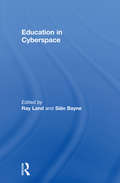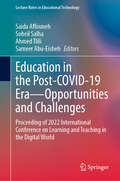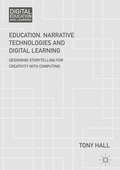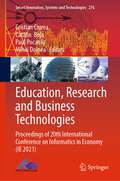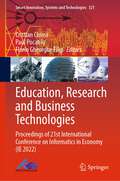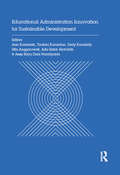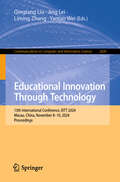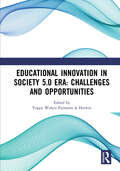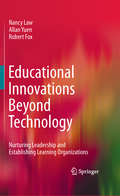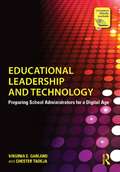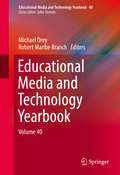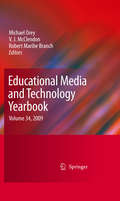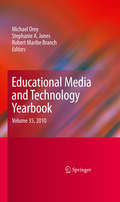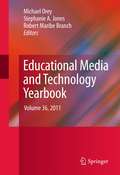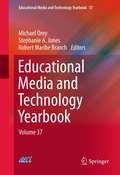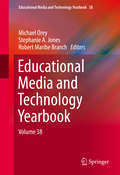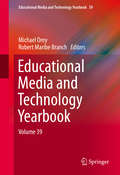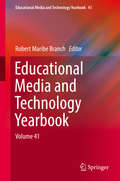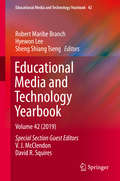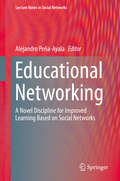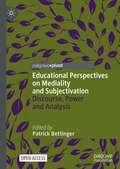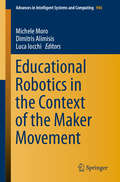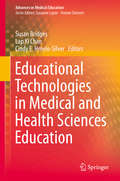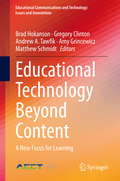- Table View
- List View
Education in Cyberspace
by Ray Land Siân BayneThe use of online learning environments is now widespread, and there is a wealth of literature providing practical advice on how to teach online, develop courses and ensure effective pedagogical practice. What has been frequently overlooked is the insight offered by cyberspace theory, which considers broader social, cultural and theoretical contexts within which new technologies and learning models are situated. This book provides a fresh perspective on current thinking in e-learning. It challenges orthodox assumptions about the role of technology in the teaching and learning of the future, and explores more varied and wider-reaching conceptual frameworks for learning in cyberspace. Featuring the contributions of respected and experienced experts with a wide range of perspectives, Education in Cyberspace will be valued by anyone closely involved in the theory of e-learning and education.
Education in the Post-COVID-19 Era—Opportunities and Challenges: Proceeding of 2022 International Conference on Learning and Teaching in the Digital World (Lecture Notes in Educational Technology)
by Ahmed Tlili Saida Affouneh Soheil Salha Sameer Abu-EishehThis book offers authors’ practices, initiatives, and experiences in sustaining their education during the pandemic from different countries, contexts, and political situations. It provides a future prediction for the education system in the world due to the transformation that happened in the post-COVID-19 era. Each chapter of the book is expected to shed light on different countries describing their education system in the past, present, and future. The readers of the book will be able to learn, compare, and analyze the differences and similarities between the educations offered to learners around the world.The book also presents a new model of e-learning that will help learners, teachers, and educational systems to participate in achieving sustainable development goals. The book introduces several scenarios of types of learning and how to plan, design, and implement them in F2F and online environments.
Education, Narrative Technologies and Digital Learning: Designing Storytelling for Creativity with Computing (Digital Education and Learning)
by Tony HallThis book examines and illustrates the potential of narrative technology, the integration and synthesis of storytelling and digital media in education. Storytelling is a foundational and powerful process in all learning and teaching, and technology is becoming ever more ubiquitous and sophisticated, particularly in its capabilities to mediate and augment creative storytelling. The book begins with a foundational analysis of narrative use in education today, and provides a history of the emergence of narrative technology. It explores how the convergence of high-potential computing and storytelling practices and techniques can be used to enhance education, in particular the design of bespoke, interactive physical learning environments. The contemporary importance of educational design is highlighted throughout the book, which concludes with the SCÉAL design-based research framework as a proposed systematic approach to the design of narrative technology in education. The book will be a valuable resource for educational designers, technologists, teachers and policymakers, especially those with an interest in the design and use of narrative technology in education.
Education, Research and Business Technologies: Proceedings of 20th International Conference on Informatics in Economy (IE 2021) (Smart Innovation, Systems and Technologies #276)
by Cristian Ciurea Paul Pocatilu Cătălin Boja Mihai DoineaThis book includes high-quality research papers presented at 20th International Conference on Informatics in Economy (IE 2021), which is held in Bucharest, Romania during May 2021. The book covers research results in business informatics and related computer science topics, such as IoT, mobile-embedded and multimedia solutions, e-society, enterprise and business solutions, databases and big data, artificial intelligence, data-mining and machine learning, quantitative economics.
Education, Research and Business Technologies: Proceedings of 21st International Conference on Informatics in Economy (IE 2022) (Smart Innovation, Systems and Technologies #321)
by Florin Gheorghe Filip Cristian Ciurea Paul PocatiluThis book includes high-quality research papers presented at 21st International Conference on Informatics in Economy (IE 2022), which is held in Bucharest, Romania, during May 2022. This book covers research results in business informatics and related computer science topics, such as IoT, mobile-embedded and multimedia solutions, e-society, enterprise and business solutions, databases and big data, artificial intelligence, data mining and machine learning, quantitative economics.
Educational Administration Innovation for Sustainable Development: Proceedings of the International Conference on Research of Educational Administration and Management (ICREAM 2017), October 17, 2017, Bandung, Indonesia
by Aan Komariah Taufani C. Kurniatun Dedy A. Kurniady Rita Anggorowati Ade Gafar Abdullah Asep Bayu Dani NandiyantoThe International Conference on Research of Educational Administration and Management (ICREAM) held on October 17, 2017 in Bandung, West Java, Indonesia. The aim of ICREAM is to provide a platform for educators, administrators, managers, leaders, policy makers, researchers, scholars, principals, supervisors, graduate students, practitioners, academicians, professionals and teachers from different discipline backgrounds to present and discuss research, developments and innovations in the fields of educational administration. It provides opportunities for the delegates to exchange new ideas and application experiences, to establish business or research relations and to find global partners for future collaboration.
Educational Innovation Through Technology: 13th International Conference, EITT 2024, Macau, China, November 8–10, 2024, Proceedings (Communications in Computer and Information Science #2600)
by Liming Zhang Jing Lei Qingtang Liu Yantao WeiThe volume CCIS 2600 constitutes the refereed post-conference proceedings of the 13th International Conference of Educational Innovation through Technology, EITT 2024, Macau, China, during November 8–10, 2024. The 17 revised full papers and 7 short papers presented in these proceedings were carefully reviewed and selected from 78 submissions. The papers are organized in the following topical sections: AI-Powered Educational Innovation, Tech-Enhanced Curriculum & Teaching Innovations, and AI-driven Learning Analytics & Assessment.
Educational Innovation in Society 5.0 Era: Proceedings of the 4th International Conference on Current Issues in Education (ICCIE 2020), Yogyakarta, Indonesia, 3 - 4 October 2020
by Yoppy Wahyu PurnomoThis book consists of a selection of papers that discuss the challenges in the increasingly complex world of education and various educational problems such as moral degradation, lack of literacy, pedagogical curriculum and innovation, educational technology. Moreover, the book provides papers that deal with educational innovation in the era of Society 5.0, with a view to discuss and resolve various social challenges, issues, and problems relating to educators, students, the dynamics of the education system, and social dynamics. The subject areas treated in this book are: Character Education in Society 5.0 Era, Multiliteracy Education in Society 5.0 Era, Early Childhood Education in Society 5.0 Era, Inclusive Education in Society 5.0 Era, Curriculum, Media and Educational Technology for Primary Education in Society 5.0 Era, Joyful and Meaningful Learning in Society 5.0 Era, and HOTS in Society 5.0 Era. This book will help educators, stakeholders, and also parents to cope with the challenges in education.
Educational Innovations Beyond Technology
by Robert Fox Allan Yuen Nancy LawThe text explores the concept of innovation, and analyse and compare different dimensions of innovation found in the various case studies; the transfer of innovation and the mechanisms of change; on an innovative online case study database on education innovations that has been designed to be used by education practitioners to support organizational leadership, international collaboration and reflective practice in the Asia Pacific Economic Cooperation (APEC) eEducation Leadership initiative; on a project aimed to support the establishment of communities of practice for education practitioners facilitated through an extendable online database that can be used to contribute and share case studies of their own ICT-supported pedagogical innovations. It discusses roles of the teacher and the anticipated changes to the education profession at a system level, in the coming decade on the basis of emerging changes observed in the case studies, and leadership issues at the school level. The book analyses change mechanisms for different kinds of innovation and how different contextual and cultural factors interact to bring about the changes observed.
Educational Leadership and Technology: Preparing School Administrators for a Digital Age
by Virginia E. Garland Chester TadejaProviding models of exemplary use and the latest research, Educational Leadership and Technology reveals the transformational power of emerging technologies to improve student learning, and explores how leaders can bring about this technology integration. This book provides an overview of roles and strategies expected of effective school leaders, as well as some of the complex issues they face. Authors Garland and Tadeja offer a critical analysis of today's emerging technology, while also addressing the need for collaborative efforts of parents, community, and students to implement technologies effectively. Special Features Include: Full integration of National Technology Standards for Administrators (NETS.A) and the National Education Technology Plan (NETP). Leader reflections from practicing school administrators that provide context of real-world scenarios. "Tips for School Leaders" and end-of-chapter questions that encourage student engagement with the text. "School Administrator's Technology Leadership Self-Assessment," a unique and impartial survey in each chapter with self-scoring guide that helps readers determine their technology use and readiness for implementation. A robust companion website with PowerPoint Slides, strategies, and links to website and video resources which will reflect changes in technology, policy, and practice. Discussion of the newest and emerging technologies, including Cloudware, social media, virtual manipulatives, and e-games. Educational Leadership and Technology is an important resource for new and aspiring elementary, middle, and high school principals as well as superintendents and technology coordinators.
Educational Media and Technology Yearbook
by Robert Maribe Branch Michael OreyThe Educational Media and Technology Yearbook has become a standard reference in many libraries and professional collections. Examined in relation to its comp- ion volumes of the past, it provides a valuable historical record of current ideas and developments in the ?eld. Part I, "Trends and Issues," presents an array of chapters that develop some of the current themes listed above, in addition to others. Part II, "Library and Information Science," concentrates upon chapters of special relevance to K-12 education, library science education, school learning resources, and various types of library and media centers--school, public, and academic among others. In Part III, "Leadership Pro?les," authors provide biographical sketches of the careers of instructional technology leaders. Part IV, "Organizations and Associations in North America," and Part V, "Graduate Programs in North America," are, resp- tively, directories of instructional technology-related organizations and institutions of higher learning offering degrees in related ?elds. Finally, Part VI, the "Medi- raphy," presents an annotated listing of selected current publications related to the ?eld. For a number of years we have worked together as editors and the sixth with Dr. Michael Orey as the senior editor. Last year as the senior editor, Orey decided to try and come up with a list of the top programs rather than just the list of all the programs. This has proven to be problematic. First of all, bias exists when we are rating a ?eld in which our program is within those to be rated.
Educational Media and Technology Yearbook, Volume 34
by Robert Maribe Branch V. J. Mcclendon Michael OreyThe Educational Media and Technology Yearbook is dedicated to theoretical, empirical and practical approaches to educational media development. All chapters are invited and selected based on a variety of strategies to determine current trends and issues in the field. The 2009 edition will highlight innovative Trends and Issues in Learning Design and Technology, Trends and Issues in Information and Library Science, and features a section that lists and describes Media Related Organizations and Associations in North America. <P><P> The Educational Media and Technology Yearbook, a scholarly resource for a highly specialized professional community, is an official publication of the AECT and has been published annually for 33 years.
Educational Media and Technology Yearbook, Volume 35
by Robert Maribe Branch Michael Orey Stephanie A. JonesThe evolution of educational technology has seen a shift from hardware and software to tactics and techniques, as the 2010 edition of the Educational Media and Technology Yearbook makes abundantly clear. As in previous years, it offers the reader a snapshot of the moment and a look ahead to issues most likely to shape the immediate future--an array as varied as the use of social networking sites in learning, new collaborations between media specialists and non-teaching school personnel, and the emerging discipline of Human Performance Technology. Here are ideas that are not only intellectually intriguing but also practical and practice-building, inspiring educators using computer technology to move beyond traditional teaching roles toward learning design. Included in the 2010 Yearbook: Salient issues in learning, design, and technology, such as the critical part school leadership plays in instructors' acceptance or rejection of technology, New trends in library and information science, including the role of school library media centers in preventing cyberbullying, This year's leadership profiles: Jerrold Kemp, author of Designing Effective Instruction; W. Michael Reed, accomplished, dedicated, and recognized educator in instructional technology, A worldwide directory of current professional associations and organizations in learning design, technology, information, and library science, Up-to-date listings of graduate program in these fields, rated using a variety of criteria, Special mediagraphy section featuring journals, ERIC documents, and media-related publications in specialized areas, including distance education, simulation/virtual reality, artificial intelligence, special education, and professional development. Academics in learning design and technology, and information and library science will welcome the latest edition of the Educational Media and Technology Yearbook as a reference, idea book, and a panoramic study of where we are now.
Educational Media and Technology Yearbook, Volume 36
by Robert Maribe Branch Michael Orey Stephanie A. JonesThe Educational Media and Technology Yearbook is dedicated to theoretical, empirical and practical approaches to educational media development. All chapters are invited and selected based on a variety of strategies to determine current trends and issues in the field. The 2011 edition will highlight innovative Trends and Issues in Learning Design and Technology, Trends and Issues in Information and Library Science, and features a sections that list and describe Media Related Organizations and Associations in North America, departments in the allied fields, and a listing of journals in the field.<P><P> The Educational Media and Technology Yearbook, a scholarly resource for a highly specialized professional community, is an official publication of the AECT and has been published annually for 35 years.
Educational Media and Technology Yearbook, Volume 37
by Robert Maribe Branch Michael Orey Stephanie A. Jones As digital devices play a more critical role in daily life than ever, more opportunities arise for innovative learning technologies—a trend on full display in the Educational Media and Technology Yearbook for 2012. This latest edition, volume 37, from the Association for Education, Communication, and Technology (AECT) notes the most current trends in the field of learning design and technology, taking into account the implications for both formal and informal learning. The majority of articles train their focus on graduate and professional goals, including an analysis of doctoral programs in educational technology and new collaborative learning platforms. Library science is a featured component of this analysis and Library Science programs are featured prominently in this analysis. Mediagraphy and profiles of leaders in the field are also included.
Educational Media and Technology Yearbook, Volume 38
by Robert Maribe Branch Michael Orey Stephanie A. JonesThe latest edition of the Educational Media and Technology Yearbook, from the Association for Education, Communication and Technology (AECT), notes the most current trends in the field of learning design and technology, taking into account the implications for both formal and informal learning. Pivotal research and discussion surrounding educational trends, leadership, organizations and programs have all been updated from volume 37. Chapters train their focus on graduate and professional goals, including an analysis of doctoral programs in educational technology and new collaborative learning platforms. Library science is a featured component of this analysis and Library Science programs are featured prominently in this analysis. This edition also features new content on mediagraphy.
Educational Media and Technology Yearbook, Volume 39
by Robert Maribe Branch Michael OreyThis book is an annual publication entering its 40th year. The series represents current trend and issues in the field of educational communications and technology, journals and other periodicals associated with the field, and the academic programs that prepare instructional technology professionals. Springer has been the publisher for the series, in cooperation with the Association for Educational Communications and Technology, for the past four years. Volume 39 will feature a section on Information Studies, in addition to updated information about programs and a new ranking of the top academic degree programs in the field of Learning, Design, and Technology.
Educational Media and Technology Yearbook: Volume 37 (Educational Media And Technology Yearbook Ser. #39)
by Robert Maribe BranchThe Educational Media and Technology Yearbook has become a standard reference in many libraries and professional collections. It provides a valuable historical record of current ideas and developments in the field. Part One of this updated volume, “Trends and Issues in Learning, Design, and Technology,” presents an array of chapters that develop some of the current themes listed above, in addition to others. In Part Two, “Leadership Profiles,” authors provide biographical sketches of the careers of instructional technology leaders. Part Three, “Organizations and Associations in North America,” and Part Four, “Graduate Programs,” are, respectively, directories of instructional technology-related organizations and institutions of higher learning offering degrees in related fields. Finally, Part Five, the “Mediagraphy,” presents an annotated listing of selected current publications related to the field.
Educational Media and Technology Yearbook: Volume 42 (Educational Media and Technology Yearbook #42)
by Robert Maribe Branch Hyewon Lee Sheng Shiang TsengThis is Volume 42 of the Educational Media and Technology Yearbook. For the past 40 years, our Yearbook has contributed to the field of Educational Technology in presenting contemporary topics, ideas, and developments regarding diverse technology tools for educational purposes. Our Yearbook has inspired researchers, practitioners, and teachers to consider how to develop technological designs and develop curricula and instruction integrating technology to enhance student learning, teach diverse populations across levels with effective technology integration, and apply technology in interactive ways to motivate students to engage in course content. In addition, Volume 42 features the Virtual Reality (VR) and Augmented Reality (AR) research and educational use cases, organized and coordinated by Vivienne and David. This section provides evidence that the affordances of AR, VR, and mixed reality, defined as an immersive multi-platform experience reality (XR), have begun to make indelible changes in teaching and learning in the United States. XR’s recent developments stimulated the editors to propose a special edition to mark the interoperability of immersive technology to push the boundaries of human curiosity, creativity, and problem solving. After years of incremental development, XR has reached a critical level of investment, infrastructure, and emerging production. The chapters included in this section illustrate how XR can push user inquiry, engagement, learning, and interactivity to new levels within physical and digital contexts.
Educational Networking: A Novel Discipline for Improved Learning Based on Social Networks (Lecture Notes in Social Networks)
by Alejandro Peña-AyalaThis book is related to the educational networking (EN) domain, an incipient but disrupting trend engaged in extending and improving formal and informal academic practices by means of the support given by online social networks (OSNs) and Web 2.0 technologies. With the aim of contributing to spread the knowledge and development of the arena, this volume introduces ten recent works, whose content meets the quality criteria of formal scientific labor that is worthy to be published according to following five categories: · Reviews: gather three overviews that focus on K-12 EN practice, mixed methods approaches using social network analysis for learning and education, and a broad landscape of the recent accomplished labor. · Conceptual: presents a work where a theoretical framework is proposed to overcome barriers that constrain the use of OSNs for educational purposes by means of a Platform Adoption Model. · Projects: inform a couple of initiatives, where one fosters groups and networks for teachers involved in distance education, and the other encourages students the author academic videos to improve motivation and engagement. · Approaches: offer three experiences related to: Wiki and Blog usage for assessment affairs, application of a method that encourages OSNs users to actively post and repost valuable information for the learning community, and the recreation of learning spaces in context–aware to boost EN. · Study: applies an own method to ranking Mexican universities based on maximal clique, giving as a result a series of complex visual networks that characterize the tides among diverse features that describe academic institutions practice. In resume, this volume offers a fresh reference of an emergent field that contributes to spreading and enhancing the provision of education in classrooms and online settings through social constructivism and collaboration policy. Thus, it is expected the published content encourages researchers, practitioners, professors, and postgraduate students to consider their future contribution to extent the scope and impact of EN in formal and informal teaching and learning endeavors.
Educational Perspectives on Mediality and Subjectivation: Discourse, Power and Analysis (Palgrave Studies in Educational Media)
by Patrick BettingerThis open access book examines the complex relationship between education, media and power. Exploring the entanglement of education media and power structures, the contributions use various examples and case studies to demonstrate how subjectivation processes and digital structures interact with one another. The book asks which modes of subjectivation can be identified with current media cultures, how subjects deal with the challenges and potential of digitality, and how coping and empowerment strategies are developed. By addressing theoretical as well as empirical evidence, the chapters illuminate these connections and the subsequent significance for media education more widely.
Educational Psychology and the Internet
by Michael GlassmanThe first comprehensive, research-based textbook on Internet-infused education, Educational Psychology and the Internet offers students an accessible guide to important issues in the field. Michael Glassman begins with an overview of the history that traces the evolution of the Internet and its significance for education. He outlines the current state of research, clearly defining terms that students will need to discuss larger concepts, such as hypertext and cyberspace. The second part of the book explores the practical applications of this research, which range from the individual-oriented to the generalized, including massive open online courses (MOOCs), open educational resources, and augmented reality. Key issues that affect teachers and students today, such as Net Neutrality and Creative Commons and Open Source licenses, are explained in straightforward terms, and often-overlooked differences - for example, between course management systems and learning management systems, and between blogs, social networking sites, and short messaging systems - are highlighted.
Educational Robotics in the Context of the Maker Movement (Advances in Intelligent Systems and Computing #946)
by Dimitris Alimisis Michele Moro Luca IocchiThis book gathers papers presented at the International Conference “Educational Robotics in the Maker Era – EDUROBOTICS 2018”, held in Rome, Italy, on October 11, 2018. The respective chapters explore the connection between the Maker Movement on the one hand, and Educational Robotics, which mainly revolves around the constructivist and constructionist pedagogy, on the other. They cover a broad range of topics relevant for teacher education and for designing activities for children and youth, with an emphasis on using modern low-cost technologies (including block-based programming environments, Do-It-Yourself electronics, 3D printed artifacts, intelligent distributed systems, IoT technology and gamification) in formal and informal education settings.The twenty contributions collected here will introduce researchers and practitioners to the latest advances in educational robotics, with a focus on science, technology, engineering, arts and mathematics (STEAM) education. Teachers and educators at all levels will find valuable insights and inspirations into how educational robotics can promote technological interest and 21st century skills – e.g. creativity, critical thinking, teamwork, and problem-solving – with a special emphasis on new making technologies.
Educational Technologies in Medical and Health Sciences Education
by Susan Bridges Lap Ki Chan Cindy E. Hmelo-SilverThis evidence-packed guide explores the growing importance of new technologies and situated learning in the vanguard of medical and health sciences education, backed by real-world clinical applications. Its dual emphasis on problem-based learning (PBL) and applied learning is reflected in the range of author perspectives, from understanding how technologies engage learners to implications for program design. Innovations covered range from wider and more targeted use of mobile devices and electronic medical records to video cases and virtual patients, in clinical contexts from family practice to specialized surgery. At the same time, chapters detail both the necessary hardware for putting these systems into place and the software needed to make them accessible to learners. Among the featured topics: Technology and group processes in PBL: An ethnographic study. What is real? Using problem-based learning in virtual worlds. Are Wikipedia articles reliable learning resources in PBL curricula? Utilizing mobile electronic health records in clinical education. Measuring emotions in medicine: methodological and technological advances within authentic medical learning environments. The deteriorating patient smartphone app: towards serious game design. Medical/health sciences educators and researchers in educational technology will look to Educational Technologies in Medical and Health Sciences Education to pinpoint current and future trends in an ever-important field.
Educational Technology Beyond Content: A New Focus for Learning (Educational Communications and Technology: Issues and Innovations)
by Brad Hokanson Gregory Clinton Andrew A. Tawfik Amy Grincewicz Matthew SchmidtThis book is the outcome of a research symposium sponsored by the Association for Educational Communications and Technology [AECT]. Consisting of twenty-four chapters, including an introduction and conclusion, it argues that informational content should not be the main element of education, and that to provide more for learners, it is necessary to go beyond content and address other skills and capabilities. It also discusses the false premise that learning is complete when the information is known, not when learners seek more: their own directions, answers, and ideas. The authors assert that the ability to synthesize, solve problems and generate ideas is not based on specific content, although education often focuses solely on teaching content. Further, they state that content can be separated from the learning process and that instructional design and educational technology must be about the skills, habits, and beliefs to be learned.
